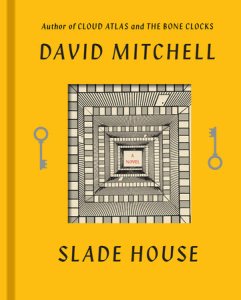Previewing the book without preempting the pleasure of reading it
A conversation with Mitchell scholars Paul A. Harris and Patrick O’Donnell
The University of Wisconsin Press journal SubStance published a special issue earlier in 2015, edited by Paul A. Harris, devoted to the extraordinary fiction of David Mitchell. A new novel from Mitchell, Slade House, debuts October 25, 2015.
Traditional book reviews of novelist David Mitchell’s writing inevitably spoil the pleasures of discovering what turn this genre-bending author’s latest work has taken; even a cursory account of plot, characters, and structure tells many Mitchell fans things they’d rather not have known. Here, Mitchell scholars Paul A. Harris and Patrick O’Donnell engage in a critical conversation about Slade House, in the hopes of piquing readers’ curiosity without making them feel piqued or PO’d.
This conversation will resume in early November, when Harris and O’Donnell will assess and respond to reviews of Slade House after it appears October 25.
PAH Patrick, I am delighted that you agreed to discuss Slade House prior to its imminent arrival (October 25) in bookstores and the mailboxes of Mitchell fans. I cannot help but point out that the opening lines of your own book on Mitchell (A Temporary Future: The Fiction of David Mitchell) fit his next novel perfectly: you cite W.G. Sebald character Austerlitz’s belief that “all the moments of our life occupy the same space, as if future events already existed and were only waiting for us to find our way to them at last, just as when we have accepted an invitation we duly arrive at a certain house at a given 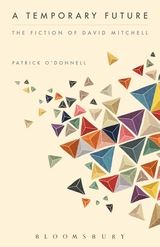 time.” Since those lines seem almost literally accurate in describing Slade House, I have to wonder what your immediate reaction was when you finished the text. Did it seem like what you would have expected of his next novel, or does it break new ground?
time.” Since those lines seem almost literally accurate in describing Slade House, I have to wonder what your immediate reaction was when you finished the text. Did it seem like what you would have expected of his next novel, or does it break new ground?
For my part, I have to confess that at first the book left me a bit flat; it felt like The Bone Clocks ‘lite’ (in terms of both literary density and weight). As I read the novel, I kept anticipating/imagining the negative reviews it seems likely to receive from canonical- and avant-garde-minded critics alike. But as I flipped around in it and thought more about it, I concluded that Slade House is even more successful than Mitchell’s prior books at managing to be both accessible and complex, popular and academic. It’s a really fast read that keeps you engaged, but on reflection it seems meta-literary in complicated, interesting ways.
POD Thanks, Paul, I am delighted to join in this conversation with you about David Mitchell’s newest novel. As you suggest, it is no surprise that Mitchell would write a novel about a house—in this case, a haunted house. The interior spaces of Mitchell’s novels are typically freighted with the past, the history of the events that have taken place therein, the memories or remnants of the characters that have inhabited them. I think Slade House is in many ways an intensification of Mitchell’s interest in the ways that time and space intersect, or perhaps a better way to think about it is that his “global” interest in those intersections has been given a specific location in a London back alley. Indeed, many of the stories that circulate through Slade House will seem familiar (if inevitably uncanny) to Mitchell’s readers as we encounter motifs and figures writ large in The Bone Clocks and percolating through all of the other novels. But I completely agree with you that what is happening here goes well beyond a continuation of the same esoteric narrative about the wars of the atemporals. I’d be interested to hear more about what your views about the metaliterary tropes and ideas of the novel.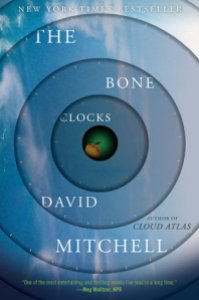
PAH Let me return to your unexpectedly apt introductory words in A Temporary Future. You wrote that “The ‘certain’ house at which one arrives in reading Mitchell—the novel one holds in one’s hands—is typically composed of many parts and genres, the architecture being neither carpenter’s gothic nor that of the sedimented multinovel, but a capacious assemblage of narratives connected to each other in differential patterns. Those patterns, detected by readers through variable acts of attention, can shift and fluctuate depending on the circumstances of one’s reading, the narrative thread that draws one’s notice at a given moment, the emergence of a sequence that compels one to recall something in a given novel’s ‘past,’ or something that seems to be lurking in its ‘future.’” These words not only apply literally to Slade House, but could also describe Mitchell’s ‘house of fiction’ as a whole. Simply put, one could say that Mitchell’s ‘house’ (Slade House and oeuvre alike) has only an ambiguous physical location and elusive materiality; one could say that it doesn’t exist in space but rather persists in time. I suppose that on one level this is true of all fiction; what would you say makes Mitchell’s work different in this regard?
POD I really like the notion of the house of Slade House as analogous to Mitchell’s “house of fiction” as a whole, and the idea that this house persists across multiple genres and temporalities but, in effect, floats in space. We could compare Mitchell’s house of fiction to the famous figure Henry James put forward in his preface to The Portrait of a Lady, where he says that the house of fiction “has in short not one window, but a million—a number of possible windows not to be reckoned, rather; every one of which has been pierced, or is still pierceable, in its vast front, by the need of the individual vision and by the pressure of the individual will. These apertures, of dissimilar shape and size, hang so, all together, over the human scene that we might have expected of them a greater sameness of report than we find. They are but windows at the best, mere holes in a dead wall, disconnected, perched aloft; they are not hinged doors opening straight upon life.” James’s figure is primarily epistemological and perspectival: reality is complex, and we perceive it, and know it, via multiple apertures, each framed by the position of the viewer and her/his “will” or capacity to see what is out there. Mitchell’s house is, by comparison, ontological, an incarceration of time and space that frames the condition of our being-in-the-world. I think one of the great attractions of a novel like Slade House is that Mitchell is enable to dramatize the immensely complex relationship between time, space, and being through an array of popular narrative genres and highly readable stories. The stories do not simplify the philosophical issues involved, they illuminate them, as light through a stained glass window illuminates religious mysteries.
But that brings me to a question for you that I think the novel raises as a continuation of the “Shaded Way” narratives that  have been circulating in Mitchell’s novels since they were first hinted at in the Mongolia chapter of Ghostwritten: what do we make of Mitchell’s ongoing interest in the connection between science and religion, or science and the “other-natural” (as compared to the “supernatural)? Any thoughts?
have been circulating in Mitchell’s novels since they were first hinted at in the Mongolia chapter of Ghostwritten: what do we make of Mitchell’s ongoing interest in the connection between science and religion, or science and the “other-natural” (as compared to the “supernatural)? Any thoughts?
PAH Pat, thank you for bring in the very apposite James passage; I completely concur with the contrast you draw between his perspectival-nuance view and Mitchell’s constructive-ontological narrative poetics. I would add that it feels like James is always looking over the shoulders of his characters; that he gives us the world from their viewpoint but he is constantly “piercing” their windows onto the world, and actually he has difficulty allowing a character’s “individual vision” or “will” to take over the narrative. Mitchell, by contrast, seems to have full-blown voices in his head that he transcribes onto the page. He is invested in getting speech, language, allusive details, and tone exactly right for the multiplicity of characters he creates, the figures who become the reader’s guides through the global tours of his books. At the Los Angeles stop of his Bone Clocks book tour, when two young aspiring novelists asked him what one should do to become a better writer, his immediate response was to listen to people, to hear acutely and precisely how people speak—the locutions and accents and diction. I remember thinking, yes, one sees that in his books; it’s just easy to forget how quickly he immerses us in his characters’ voices, because when we think about his texts, it’s the innovations in form, settings, and intertextuality that stand out, plus the philosophical/cultural questions he raises (mortality, power, genocide, predation). There are inevitable echoes across his different voices—I recall one reviewer somewhat snarkily stringing together similar-sounding quotes from characters across Bone Clocks—but the passages were all the kind of pithy riffs/aphoristic formulations that Mitchell excels at and understandably (in my view) cannot resist writing. It’s not the case that all his characters speak in similar voices in general.
To me, Mitchell’s ability to transcribe voices onto the page operates in an interesting way—sometimes I think he is a ventriloquist; at other times it seems as if he’s the dummy. This connects to the question you posed, because I remember that my first response to the noncorporeal intelligence of the Mongolia chapter in Ghostwritten was that it was a simple, literal embodiment or allegory of narration—particularly Mitchell’s narrative mode, ‘transmigrating’ from one mind to another as he changes chapters. In Temporary Future you neatly characterize that character’s consciousness as “an assemblage of overlapping and differentiated cognitive maps, languages, fragmentary memories, and partial histories,” and read it as a metaphor for connections among strangers across time and space, as well as a figure for the fractured nature of identity in Mitchell. I agree with this and by comparison what I saw is quite basic—the transmigration is a map of the narration’s itinerary, an image of Mitchell’s own constructive, creative journey from one person-place to another.
In terms of the question of the ‘other-natural,’ it does seem puzzling that Mitchell repeatedly disavows belief in anything beyond the material or natural, yet repeatedly returns to fantastic elements in his fiction that suggest otherwise.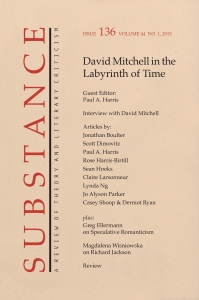 I think it might be possible to sort of invert the question: it is precisely the ability of narration to move magically, fantastically, across time and space, to inhabit other minds, to bring them to life and let them expire, or to have them hop into another head instead—‘other-natural’ elements or dimensions would just be an extension of these powers of narration. When I asked him about this issue in the interview for SubStance, he said:
I think it might be possible to sort of invert the question: it is precisely the ability of narration to move magically, fantastically, across time and space, to inhabit other minds, to bring them to life and let them expire, or to have them hop into another head instead—‘other-natural’ elements or dimensions would just be an extension of these powers of narration. When I asked him about this issue in the interview for SubStance, he said:
“Maybe it’s worthwhile to note that a novel is a zone of near-infinite possibilities, where contradictory elements can co-exist, including temporal ones. The Bone Clocks is about mortals like us . . . as well as pseudo-immortals like the Anchorites . . . as well as the Horologists, who have a ‘Serial Repeater’ time-scale; and that’s okay, assuming you think the novel works. If The Bone Clocks was an astrophysics dissertation, I’d have my academic ID revoked and be escorted to the campus gate by security, and quite right too. Because it’s a novel, I get away with it. The other handy thing about novels is that while they explore, they don’t have to arrive at tidy conclusions.”
So, to me, Mitchell’s work invokes the ‘other natural’ as a possible world as a function of fiction’s power to produce infinite possible worlds. Maybe I am just using Mitchell’s ducking of the question to duck the question. . . . Bringing this back to Slade House, I felt that the way that the antagonists construct characters and the house clearly maps to Mitchell’s sense of the unlimited powers of the author to make up anything at any time, and to change the game as he or she sees fit.
After all that, then, I can only echo your unanswered question back to you: what do you make of Mitchell’s ongoing interest in the connection between science and religion, or science and the “other-natural” (as compared to the “supernatural)?
POD I’m really intrigued by your statements about Mitchell’s ventriloquism, and I quite agree that he has an amazing capacity to capture and throw an assemblage of voices in his novels. This reminds me of Dickens, who knew a good deal about ventriloquism in the nineteenth century, and who was observed by his daughter, Mamie, to be “practicing” the voices of his characters before a mirror. Like Dickens, the convincingness of Mitchell’s voices have to do not just with matters of pitch and locution, but also with location—the planetary spaces that Mitchell is able to evoke both in the past and in the future. One of the things that would distinguish him from a Charles Dickens—picking up on your point about Mitchell’s character—and worlds-hopping—is his invocation of multiple worlds in adjacency, the multiple realities or, as Ursula Heise would put it, “chronoschisms” that Mitchell’s readers are encouraged to inhabit as stories and as formal structures. In a sense, both James and Dickens are after a kind of mastery—James (especially late James) to represent the totality of a consciousness or perspective, Dickens to trace the master plot behind all of the subplots and seemingly disconnected narratives of urban cacophony. I think the difference in Mitchell is that, as an author, he is not interested in mastery: as you elegantly put it, he brings plots, worlds and characters to life and allows them to expire, often in medias res. This may be going a bit out on a limb, but one of the great attractions of Mitchell’s narratives is their stories, made up in a very traditional sense of compelling characters and interesting, suspenseful plots; however, as an author (and of course this is something of a trompe d’oeil) he is far less anxious than Dickens or James about forsaking his authority over them; he seems not particularly worried about the form of singularity that we term “author,” though of course he has attained great visibility and, even, celebrity status despite his self-effacing authority. In other terms, he generates multiple, partial worlds and stories that make room for readers to connect, recall, and retell; in effect, he forsakes his authority, or alternatively, he allows readers the sense that they are co-authoring the work.
Bringing this back to Slade House, you’ve already suggested a number of ways that we could view this novel as a series of stories that entail metanarrative consequences for Mitchell’s own “house of fiction.” Not too fancifully, I think, we could consider all of Mitchell’s novels as “slade houses” (with the obvious pun on “slade/slayed”) through which his living-dying characters circulate in time. While, as devotees of “the Shaded Way” (adding a third resonance to “slade/slayed/shade”), the antagonists of Slade House seek immortality via the obscene consumption of souls, they fail over time—time itself is their enemy—as do the vampiric “immortals” of The Bone Clocks, Cloud Atlas, and Ghostwritten; in the end, they die, every single one of them. And the protagonists in this metaphysical battle, the Atemporals, also can and do die; in fact, death is essential to their being, as is the case with Marinus, who makes his/her reappearance as a psychiatrist from Toronto in Slade House. I think through all of this that Mitchell sees mortality, the fact of death that comes to us all, as the primary condition of being human, and all of our attempts to circumvent death (and time, for that matter), as the engine behind the construction of empires, the accumulation of wealth, the quest for power, and the recurrence of war—as if, in the latter, we can defeat death by incurring it everywhere.
And this then takes me to responding to your call out on the question of the relation between science and religion in Mitchell. I couldn’t help laughing at Mitchell’s saying that if The Bone Clocks was an astrophysics dissertation, his academic ID would be revoked and he’d be escorted to the exit by campus security. Yet if you read some of the material with which Mitchell is clearly acquainted on quantum physics, the concept of black holes or the many-worlds interpretation would sound no more outlandish to skeptical ears than the idea of an ongoing war between two semi-immortal factions taking place in a parallel universe that, every so often, encroaches upon human individuals in the “real” world. I think Mitchell is interested in the deep connections to be perceived across history between religion and science, both disciplines premised upon systems of belief that offer the potential of extended life or life after death. I can hear the empiricists scoffing at this, but what else is behind the multilayered and extending scientific quests that inform cybernetics (replacing mortal elements with mechanical parts that last longer following an infinite logic of substitution), astrophysics (in the attempt to understand the origins of the universe and the limitations on its near-infinite expanse), mathematics (in the abstractions infinite numbers), or genetics (in the attempt to create a complete DNA map and thus genetically produce individuals who can live longer, and perhaps even be reborn after death through cryogenics). I think Mitchell in his fiction is particularly attuned to how driven we are to find a way to cheat death. Authors do this in their writing (which they hope will live well beyond them in future generations of readers); Mitchell generates a form of writing which takes as a principle theme the good and bad consequences of this “life-drive.”
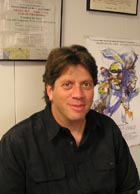
Paul Harris
Paul A. Harris is a co-editor of SubStance and a professor of English at Loyola Marymount University. He served as president of the International Society for the Study of Time from 2004-2013 and edited the recent SubStance issue David Mitchell in the Labyrinth of Time. His current project is The Petriverse of Pierre Jardin.
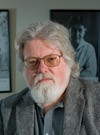
Patrick O’Donnell
Patrick O’Donnell is a professor of twentieth- and twenty-first-century British and American literature at Michigan State University; he is the author and editor of over a dozen books on modern and contemporary fiction, most recently, The American Novel Now: Reading American Fiction Since 1980 (Wiley-Blackwell, 2010), and A Temporary Future: The Fiction of David Mitchell (Bloomsbury, 2015). He is currently working on a book about Henry James and contemporary cinema.

